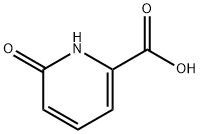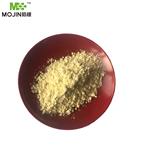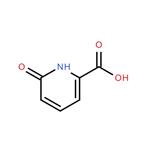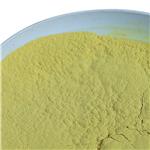6-Hydroxypicolinic acid is prepared by the reaction of 2-Bromo-6-hydroxypyridine and Carbon Dioxide. The specific synthesis steps are as follows:
To a solution of 2-bromo-6-hydroxypyridine (0.76 g, 4.4 mmol,1.0 equiv.) in dry THF (20 mL) at 0 C was added a 2 M solution of -PrMgCl in THF (2.2 mL,4.4 mmol, 1.0 equiv.) during 5 min. The clear solution was stirred at that temperature for anadditional 5 min, and a 2.5 M solution of n-BuLi in hexanes (3.5 mL, 8.8 mmol, 2.0 equiv.) wasadded dropwise during 5min, while maintaining the temperature below 20 C. The resultingmixture was stirred at that temperature for 0.5 h, dry CO2 (0.20 g, 1.0 equiv.) was added to20 C. The resulting mixture was warmed to 20 C in 0.5 h and quenched with water (6 mL).After stirring the mixture below 20 C for 10 min, the phases were separated and the water phasewas extracted one additional time with ethyl acetate. The resulting suspension was allowed to reachroom temperature and fitered through a mbox0.5 1 cm pad of silica gel eluted with 10 mL of ethylacetate. The ?ltrate was concentrated and the residue was puri?ed by ash chromatography on silicagel (eluent: petroleum ether/ethyl acetate = 10:1) to afford product 3m as off-white solid, 0.56 g (yield: 93percent) , m.p.: 275–277 C. 1H-NMR (600 MHz, DMSO) 7.56 (dd, J = 8.9, 7.0 Hz, 1H), 6.97 (d, J = 6.8 Hz,1H), 6.65 (d, J = 9.0 Hz, 1H). 13C-NMR (151 MHz, DMSO) 163.28, 162.67, 140.51, 137.97, 123.88, 110.42.





